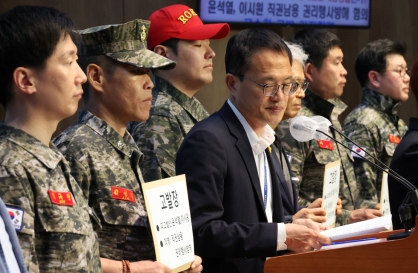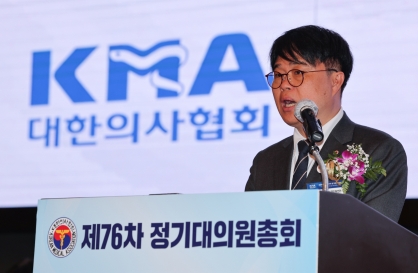It has become even more difficult to implement visible steps that would lessen Okinawa Prefecture’s burdens as the host of many U.S. military bases. The government must recognize that this situation is extremely serious.
The armed services committees of the U.S. Senate and the House of Representatives have agreed on revisions to a bill for the National Defense Authorization Act for fiscal 2012, which includes a freeze on the entire $156 million budget for shifting U.S. marines stationed in Okinawa Prefecture to Guam. The revised bill is scheduled to be approved at plenary sessions of both chambers shortly.
The Guam relocation budget was earmarked for constructing the headquarters building and family residences, as well as for the relocation of 8,000 marines and their about 9,000 family members from Okinawa Prefecture. The budget has been cut in the past, but this was the first time the entire budget was frozen.
The U.S. Congress has been trying to cut massive defence spending. It has been toughening its stance of not approving the Guam relocation budget unless progress is made on the relocation plan of Futenma Air Station in Okinawa Prefecture, which is considered a “set” with the marines’ relocation.
If there is no budget for the program in fiscal 2013, the Guam relocation plan itself likely would face being scrapped. If that should happen, the scheduled return of six U.S. military facilities in southern Okinawa Prefecture to Japan’s rule ― a key element in the realignment of U.S. forces in Japan ― would also face a setback.
Many people in Okinawa Prefecture want the issue of moving the marines to Guam to be separate from the Futenma station’s relocation within the prefecture. However, they should recognize such a plan is unrealistic.
The U.S. government tried to persuade Congress not to freeze the funds because it believed a degree of “tangible progress” would be made if the Japanese government submits an environment impact assessment statement to the prefecture within the year as planned. However, the efforts at persuasion failed.
A “far more substantial development” in the Futenma issue will be necessary to convince Congress to revive the Guam relocation budget in fiscal 2013.
There are only two options left for Tokyo and Washington, as well as the Okinawa prefectural government.
One is to move ahead with the relocation of the Futenma base to the Henoko district in Nago, also in the prefecture, and realize the U.S. marines’ relocation to Guam. When the six U.S. military facilities are returned to Japan’s rule, the availability of these vast sites will give momentum to a new revitalization plan for the island prefecture from next fiscal year.
The other is to give up both the Futenma relocation to Henoko and the transfer of the marines to Guam. In this case, those involved will have to accept that the dangerous situation of the Futenma base, located in the middle of a city, will remain for a long time.
The central and Okinawa prefectural governments must recognize the reality that only two options are left. It is essential that they discuss straightforwardly and seriously how to ensure Japan’s security while lessening Okinawa Prefecture’s burdens.
Of course, the responsibility for the current situation rests with former Prime Minister Yukio Hatoyama and other officials. After all, they proposed relocating the Futenma base somewhere outside the prefecture or even outside the country, a suggestion that built up unreasonable expectations among many Okinawa residents ― and then eventually betrayed these hopes.
Prime Minister Yoshihiko Noda has not visited Okinawa Prefecture since he assumed the post. It is about time he stood up to break the deadlock.
(The Yomiuri Shimbun)
(Asia News Network)
The armed services committees of the U.S. Senate and the House of Representatives have agreed on revisions to a bill for the National Defense Authorization Act for fiscal 2012, which includes a freeze on the entire $156 million budget for shifting U.S. marines stationed in Okinawa Prefecture to Guam. The revised bill is scheduled to be approved at plenary sessions of both chambers shortly.
The Guam relocation budget was earmarked for constructing the headquarters building and family residences, as well as for the relocation of 8,000 marines and their about 9,000 family members from Okinawa Prefecture. The budget has been cut in the past, but this was the first time the entire budget was frozen.
The U.S. Congress has been trying to cut massive defence spending. It has been toughening its stance of not approving the Guam relocation budget unless progress is made on the relocation plan of Futenma Air Station in Okinawa Prefecture, which is considered a “set” with the marines’ relocation.
If there is no budget for the program in fiscal 2013, the Guam relocation plan itself likely would face being scrapped. If that should happen, the scheduled return of six U.S. military facilities in southern Okinawa Prefecture to Japan’s rule ― a key element in the realignment of U.S. forces in Japan ― would also face a setback.
Many people in Okinawa Prefecture want the issue of moving the marines to Guam to be separate from the Futenma station’s relocation within the prefecture. However, they should recognize such a plan is unrealistic.
The U.S. government tried to persuade Congress not to freeze the funds because it believed a degree of “tangible progress” would be made if the Japanese government submits an environment impact assessment statement to the prefecture within the year as planned. However, the efforts at persuasion failed.
A “far more substantial development” in the Futenma issue will be necessary to convince Congress to revive the Guam relocation budget in fiscal 2013.
There are only two options left for Tokyo and Washington, as well as the Okinawa prefectural government.
One is to move ahead with the relocation of the Futenma base to the Henoko district in Nago, also in the prefecture, and realize the U.S. marines’ relocation to Guam. When the six U.S. military facilities are returned to Japan’s rule, the availability of these vast sites will give momentum to a new revitalization plan for the island prefecture from next fiscal year.
The other is to give up both the Futenma relocation to Henoko and the transfer of the marines to Guam. In this case, those involved will have to accept that the dangerous situation of the Futenma base, located in the middle of a city, will remain for a long time.
The central and Okinawa prefectural governments must recognize the reality that only two options are left. It is essential that they discuss straightforwardly and seriously how to ensure Japan’s security while lessening Okinawa Prefecture’s burdens.
Of course, the responsibility for the current situation rests with former Prime Minister Yukio Hatoyama and other officials. After all, they proposed relocating the Futenma base somewhere outside the prefecture or even outside the country, a suggestion that built up unreasonable expectations among many Okinawa residents ― and then eventually betrayed these hopes.
Prime Minister Yoshihiko Noda has not visited Okinawa Prefecture since he assumed the post. It is about time he stood up to break the deadlock.
(The Yomiuri Shimbun)
(Asia News Network)






![[Weekender] How DDP emerged as an icon of Seoul](http://res.heraldm.com/phpwas/restmb_idxmake.php?idx=644&simg=/content/image/2024/04/25/20240425050915_0.jpg&u=)


![[Music in drama] An ode to childhood trauma](http://res.heraldm.com/phpwas/restmb_idxmake.php?idx=644&simg=/content/image/2024/04/25/20240425050929_0.jpg&u=)








![[Herald Interview] Mistakes turn into blessings in street performance, director says](http://res.heraldm.com/phpwas/restmb_idxmake.php?idx=652&simg=/content/image/2024/04/28/20240428050150_0.jpg&u=20240428174656)
